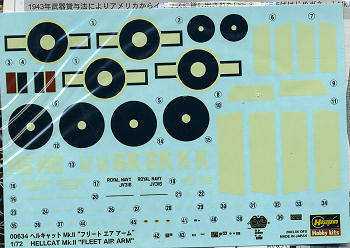
Hasegawa 1/72 Hellcat Mk. II 'Fleet Air Arm'
| KIT #: | 00684 |
| PRICE: | $14.35 from www.greatmodels.com |
| DECALS: | Two options |
| REVIEWER: | Scott Van Aken |
| NOTES: | 2003 limited reissue |

| HISTORY |
The most successful US Navy fighter of WW II is not the Corsair, but the Hellcat. Grumman designed a plane that was easy to fly and easy to land on a carrier, making even the least experienced pilot look good. Sort of like modern Tamiya kits. Not only that, they were heavily armed with 6 .50 cal machine guns, had superb power and excellent maneuverability. They also hit the scene after most of Japan's best pilots had been killed or badly injured so the quality of the opposition wasn't what it was. Regardless of that, the Hellcat was the right plane at the right time. Even after the war, the plane was flown by the Reserves, the French and by Uruguay. Today, several are extant in museums and a few still fly as warbirds.
| THE KIT |
 Probably
one of Hasegawa's better sellers, their F6F Hellcat kit is not exactly a new
kit. In fact, it may well have been one of its last new mold kits that had
raised detail. Now this isn't exactly a bad thing as the detailing is quite well
done.
Probably
one of Hasegawa's better sellers, their F6F Hellcat kit is not exactly a new
kit. In fact, it may well have been one of its last new mold kits that had
raised detail. Now this isn't exactly a bad thing as the detailing is quite well
done.
The kit does suffer from some flash thanks to the age of the molds. Nothing major, but one will have to do some clean-up of most of the parts. Typical of Hasegawa's limited reissues, the plastic is exactly the same as the original boxing. That particular kit had the option to do an F6F-3 or F6F-5 as there are two canopy styles and the unneeded for this boxing rear quarter windows. The two little 'bumps' that go on the aft portion of the cowling on either side are also in there, but not needed. One thing that Hasegawa never did incorporate into their 1/72 Hellcat are the rocket rails and rockets that were part of the -5 upgrade.
Nevertheless, the kit is still nicely done. There are ejector marks
on the gear legs, wheels and doors and the cockpit is rather Spartan, consisting
of a stick and instrument panel with a seat that fits onto
 a
small raised section and a back bulkhead. It really does need a replacement
cockpit. Instrument panel has a decal to fit in place. The engine is quite
generic, but for most purposes is adequate. The drop tank is the only underside
option.
a
small raised section and a back bulkhead. It really does need a replacement
cockpit. Instrument panel has a decal to fit in place. The engine is quite
generic, but for most purposes is adequate. The drop tank is the only underside
option.
Instructions are like every Hasegawa kit sheet you've seen in the last 20 years. Gunze references for paint. An addendum sheet is included to be sure you use the right bits for a Hellcat II (basically an F6F-5). Markings are provided for two subjects. One is the box art plane (which shows the rocket rails but trust me, they are not included) in overall sea blue from 1844 squadron in 1945. The other is one repainted in FAA colors with large white bands on the wings and tailplanes. This one is from 804 squadron, also during 1945. The decals are well printed, but of the 'old' variety which means the whites are an off-white and they may or may not succumb to setting solutions.
| CONCLUSIONS |
Probably wondering why one would buy this 'old' kit. Well for one, it is well designed and builds rather quickly, thanks to a lack of fiddly bits. Second, though the Academy kit is nice and has engraved panel lines, most like the Hasegawa kit better. Aftermarket bits abound and you can replace a bunch of things if you are so inclined. One thing for sure, if you like Hellcats, you'll like this kit. I've built several of various boxings and they are favorites.
ou can find this and many other quality kits and accessories at GreatModels
If you would like your product reviewed fairly and quickly, please contact me or see other details in the Note to Contributors.